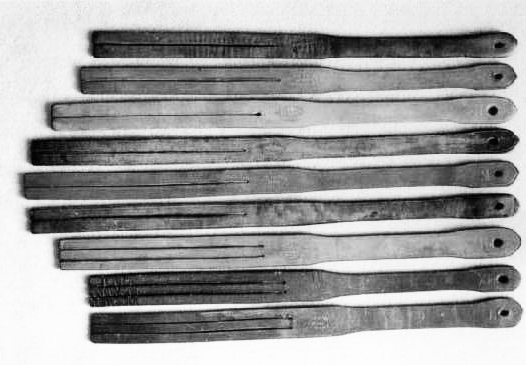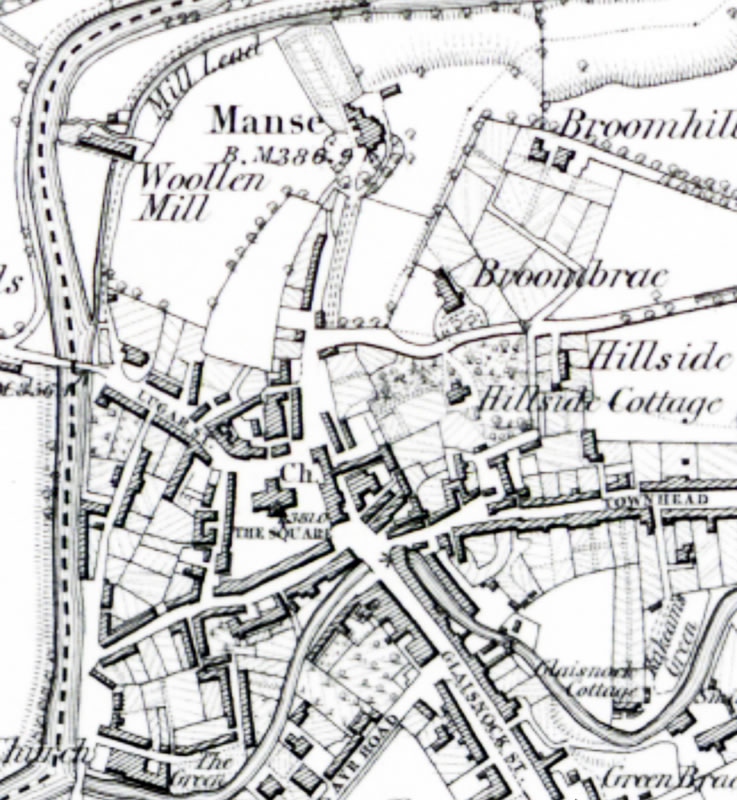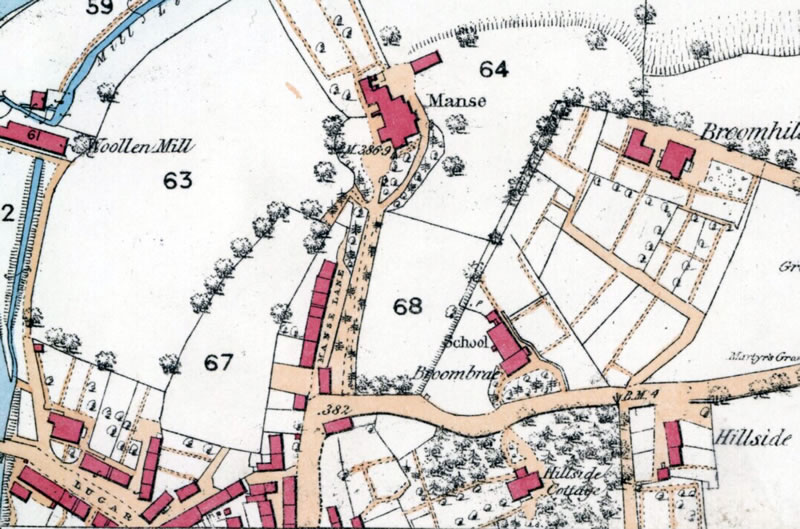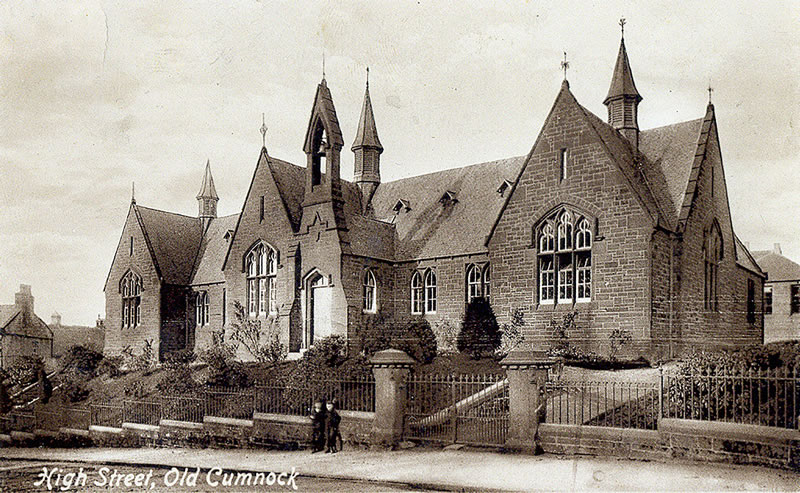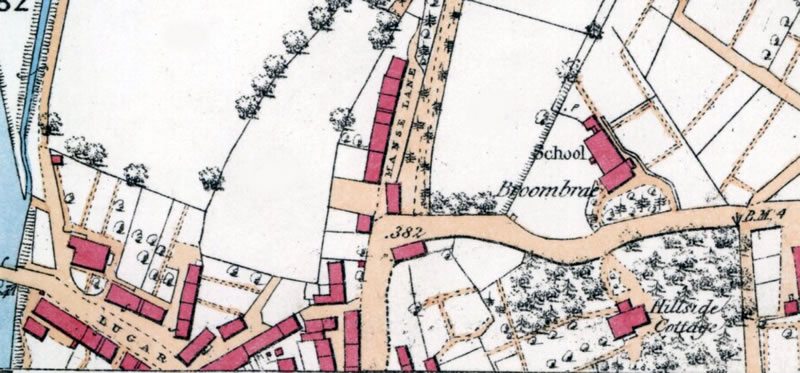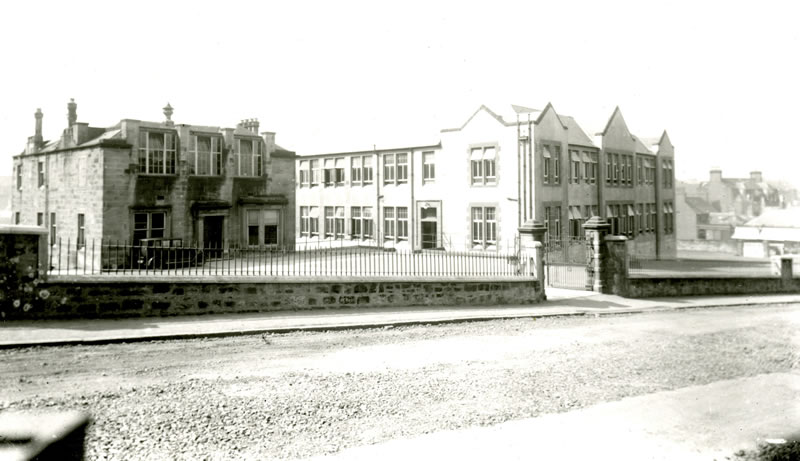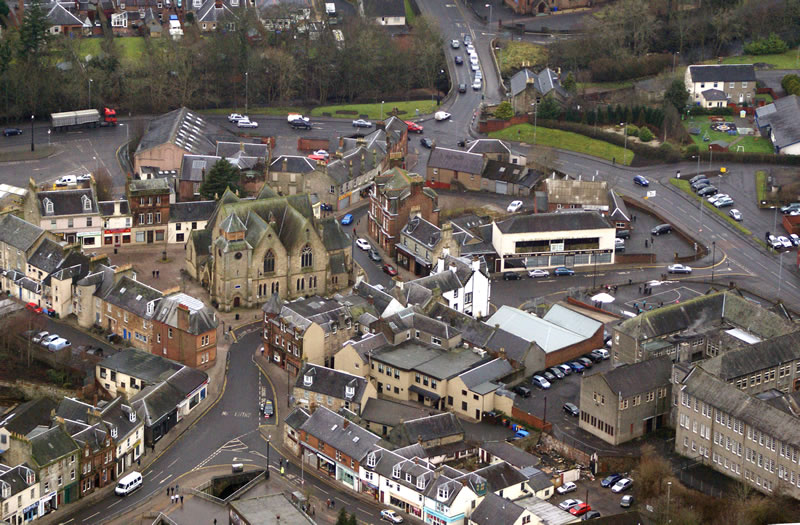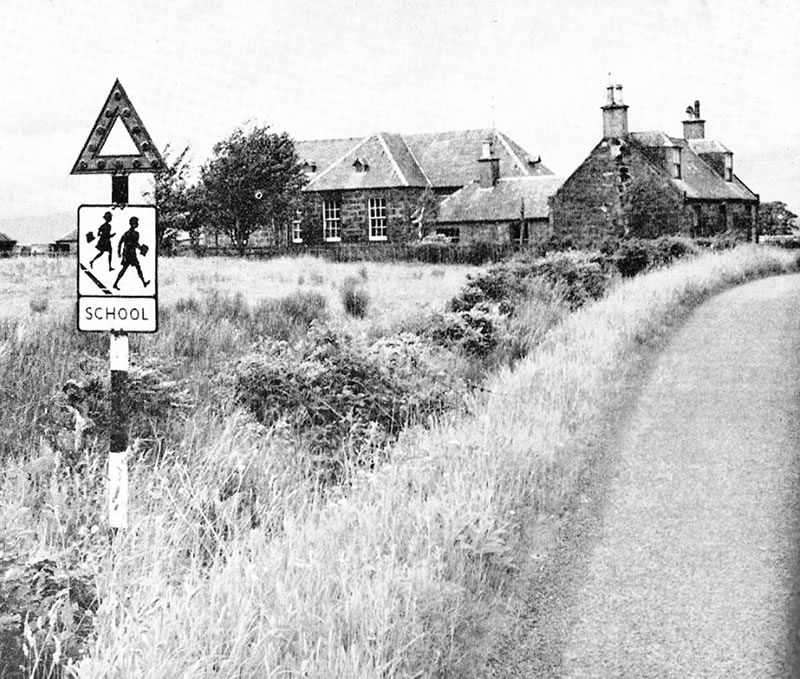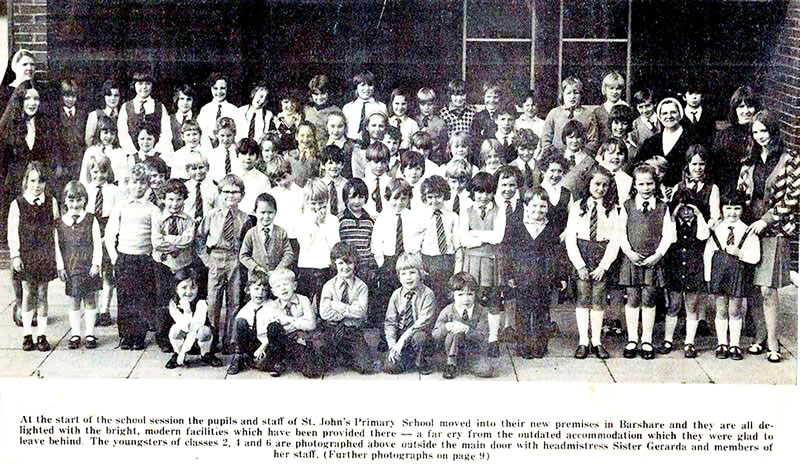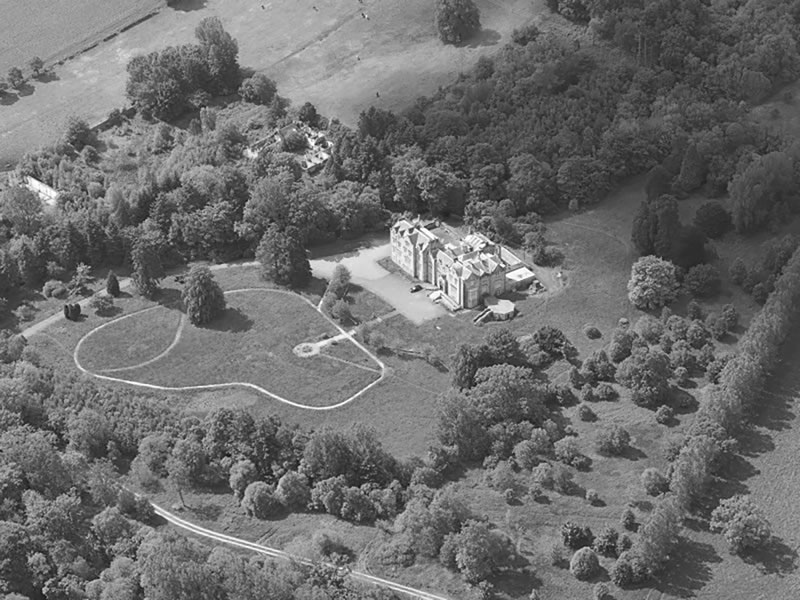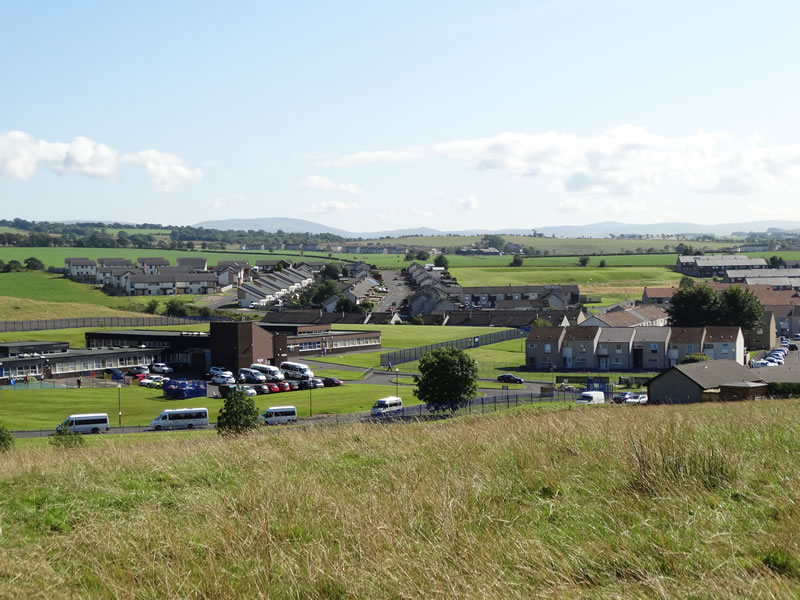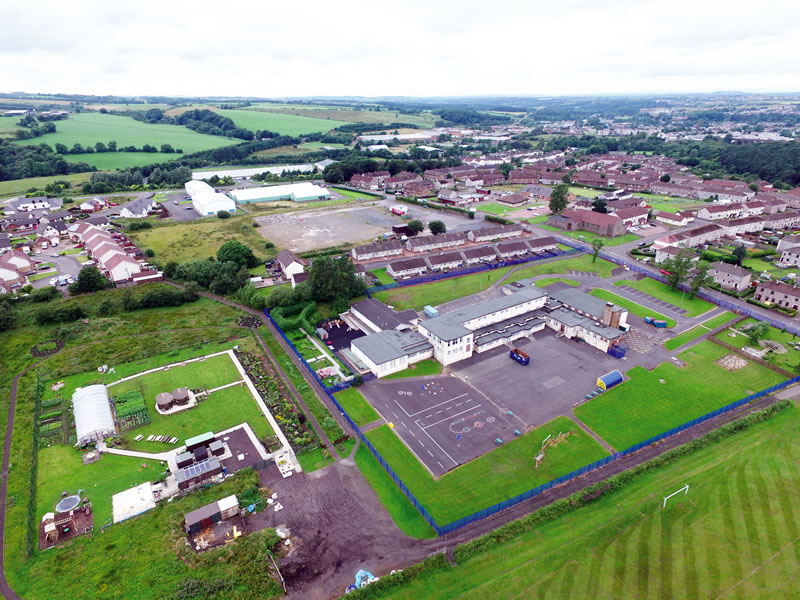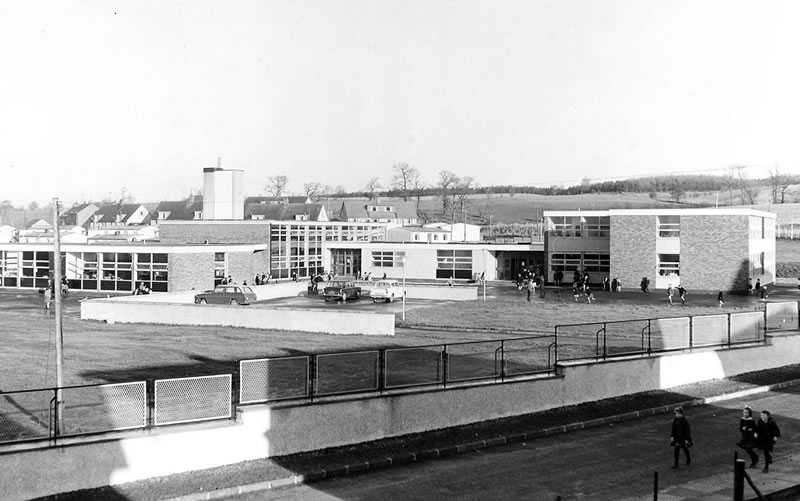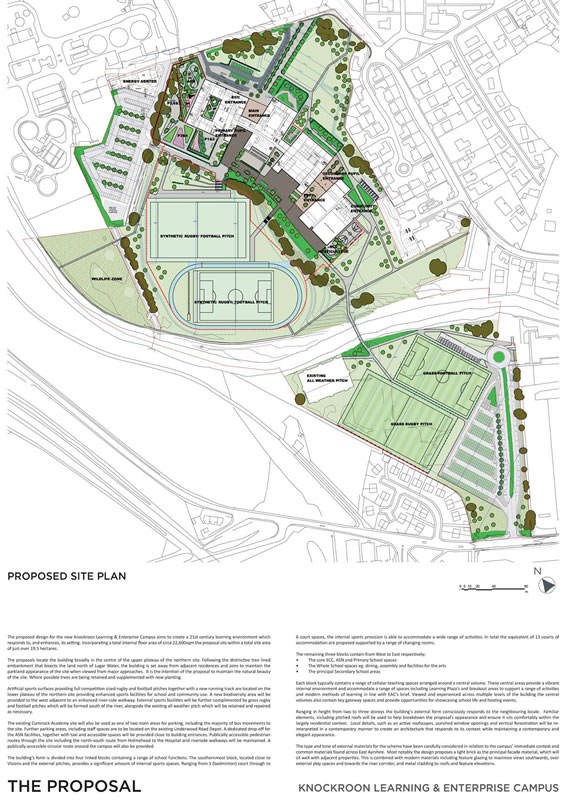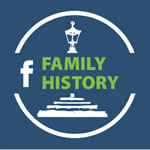Schools & Education
There is a long history of education and school buildings in the Cumnock area. Here we look at that story.
By Bobby Grierson
Scottish education has always been held in high regard and the history of education in the Cumnock area is a good example of how this came about.
Early Times
In the early 1600s it was planned to set up a school in every Parish and although it took almost two centuries for this to be realised – things were not at a standstill. The earliest mention of a school in Cumnock being 1625. It is not known exactly where this was situated, but it was somewhere close to the Parish Church. In early Cumnock maintaining standards of education was the responsibility of the Church and the Parish Heritors Committee. Annual examination of school and pupils would be held by the Parish Minister and one or two neighbouring clergymen. Later control of schools and school affairs passed into the hands of school boards, members of which had to be elected. Increasing population and the rise in school rolls meant that schools became overcrowded.
Early records show in the 1830s the Parish School and the town jail occupied the site of the present day Clydesdale Bank in the Square. This operated alongside several private and church schools. By the 1840s the school needed to expand and a new Parish School was erected at Broombrae by the Heritors Committee and opened in 1847.
Parents were expected to pay for school fees and some examples from this era are given here: Reading 3/-, Writing 3/6d, Arithmetic 4/, Latin 6/- all per quarter. Some bequests were granted to educate poorer children by the Marquis of Bute and Charles Duncan a local benefactor.
Victorian Times
In 1872, after the passing of the Education Scotland, Cumnock moved to a system of state-sponsored, largely free schools and education was now compulsory from five to thirteen. In 1873 Old Cumnock School Parish Board was formed and control of schools and school affairs passed into their hands. Due to the rise in school rolls preparations were made for a rebuilding scheme and to design two large new schools, at Garrallan and in the town.
Garrallan Parish School on the Skares Road was opened in 1874 and served mining and farming families. Three sites were considered for the town school, Greenmill Holm, Car Road and beside the old school in Barrhill and in 1876 a “fine, new school” was opened further up from the old school on Barrhill Road. This was Cumnock Public School and many Cumnockians would master the “three Rs” under its roof. The pupils from the old parish school and the Free Church school at Ayr Road moved in to the new building. At this time there was two joint headmasters at the new school.
In 1886 a Roman Catholic Primary School, St John’s opened in Bank Avenue with 99 pupils. In 1888 a Leaving Certificate Examination was introduced and in1890 school fees were abolished, creating a state-funded national system of free basic education and common examinations.
Around 1895 a new brick-built school was opened at Skares to serve the children of the miners rows. Meanwhile in Cumnock, between 1895 and the early 1900s the school accommodation again became woefully inadequate and a new infant block was built behind the public school in the playground and plans for a new school on the grounds of Hillside House opposite were made. In 1909 Hillside House was purchased by the school board and converted for use as a school – it opened in 1911. It soon became too small and a large extension was added which became Cumnock Academy in 1926. Hillside House itself was demolished and a new wing was added 1939.
Modern Times
With the raising of the school leaving age in 1947 and more pupils staying on, the secondary roll swelled and by 1948 the school had reached 1,443 making Cumnock Academy the biggest school in the county - the infant and primary buildings alongside the old and new extension of the Academy, and even the old parish school were full to capacity. In 1952 new plans were laid and the foundations were laid for a new primary school at Greenmill Holm at Ayr Road. Glaisnock Rural Junior Secondary School opened at nearby Glaisnock House in 1952.
The new Greenmill primary school opened in 1954 then extended. With the centralisation of secondary education Cumnock Academy now had to accommodate all pupils over the age of twelve years from the Cumnock and New Cumnock areas. It again became very overcrowded.
The increase in Cumnock Academy’s population was due partly to the town itself continuing to expand. New houses had been built at Netherthird, Craigens, Logan and Barshare and in 1961, the new St Conval’s secondary school was built on Auchinleck Road.
In 1965 plans for a new Academy were approved and a start was made with the building of the new school around the Greenmill Primary site. The two schools swapped locations in 1969 - causing much confusion at the time. The Social and Recreational Wing was added in 1971.
A new St John’s Primary School was opened at Barshare in 1974 and Barshare Primary School opened in 1976. Hillside School for children with complex learning needs was opened at Barshare in 1992.
Knockroon Learning and Enterprise Campus
The Scottish Government commitment and vision for the national school estate resulted in the development of a new school estate strategy, Building Better Schools: Investing in Scotland's Future which was published in 2009. This document set out national and local government’s shared vision, aspirations and principles for the efficient and effective management of the school estate.
Considering the key aspirations of this strategy, and the wider implications of East Ayrshire Council’s own Transformation Plan and vision for delivery of Curriculum for Excellence in schools, it was proposed to seek public comment and to bring forward proposals which would see the establishment of a new Enterprise and Learning Campus which would include provision for Early Childhood, Primary, Special, Supported Learning, Secondary on a single Campus in the Knockroon/Broomfield area.
Based on projected rolls for the schools provided by the Government it was estimated that the Affordability Cap for the Council element of the campus would be approximately £63.500m. The East Ayrshire Learning Campus - Knockroon will be the biggest capital project ever undertaken by East Ayrshire Council.
The new Campus will incorporate:
- Barshare Primary School, Supported Learning Centre and Early Childhood Centre
- Greenmill Primary School and Early Childhood Centre
- Hillside ASN School
- Auchinleck Academy
- Cumnock Academy and Supported Learning Centre
East Ayrshire Council is committed to delivering an inclusive learning environment where state-of-the-art facilities are provided for its children, young people and members of the community. A further focus on health and wellbeing should ensure this commitment extends to the outdoor facilities and the plan is to provide enhanced leisure and recreational facilities for all members of the community who currently use the existing Broomfield site.
Children and young people, staff, parents and the local community will play a significant role in developing the design for the campus. They have been invited to work with the design team and senior officers to ensure the design of the campus reflects the educational aspirations of the Council, takes into account the requirements of the local community and is informed by the natural heritage and architecture of the surrounding area.
Subject to completion of all necessary consultations and procurement procedures, construction is planned to begin in 2017, with a planned opening scheduled for 2019.
Since the 1840s Cumnock school overcrowding had been a major problem that has persisted over the years - It remains to be seen if these issues will now be successfully resolved in 2019 - almost 170 years later.
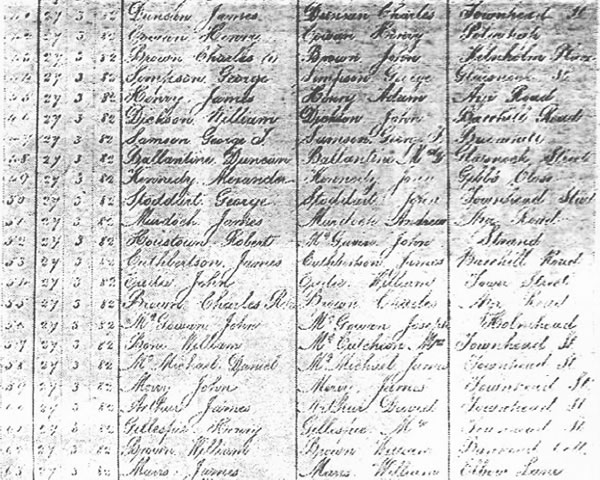
Pubic School class roll from 1882
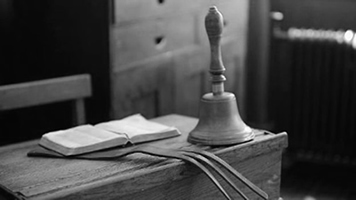 Many people educated in Cumnock will have some not so happy memories of ‘sair haunds’ from their schooldays in Cumnock. Two items ruled school life - the Bell and the Belt. One called you to lessons, the other made sure you did them. For children schooled in Scotland right up until the 1980s, a particular leather product was the source of fear and dread - the Lochgelly Tawse.
Many people educated in Cumnock will have some not so happy memories of ‘sair haunds’ from their schooldays in Cumnock. Two items ruled school life - the Bell and the Belt. One called you to lessons, the other made sure you did them. For children schooled in Scotland right up until the 1980s, a particular leather product was the source of fear and dread - the Lochgelly Tawse.
It was the Scottish school's corporal punishment weapon of choice against unruly students and enforced a strict atmosphere in classrooms from Shetland to the Borders. While students throughout the rest of the UK were punished by use of belt or cane, Scottish teachers used this modified version of the belt. The belt was used mainly by male teachers but some female teachers were known to use it too. Some male teachers would keep their belt under their jacket and draped over their shoulder for quick and easy access.
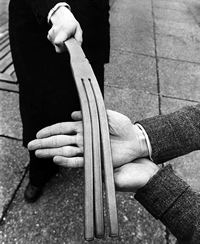 The belt consisted of a strip of leather, with one end split into a number of tails. The thickness of the leather and the number of tails was variable. Many Scottish saddlers made tawses for local schoolmasters. The official name "tawse" was hardly ever used in conversation by either teachers or pupils, who instead referred to it as either the school strap or the belt.
The belt consisted of a strip of leather, with one end split into a number of tails. The thickness of the leather and the number of tails was variable. Many Scottish saddlers made tawses for local schoolmasters. The official name "tawse" was hardly ever used in conversation by either teachers or pupils, who instead referred to it as either the school strap or the belt.
Scottish schools used the belt to punish pupils of either sex on the palm of the outstretched hand. Pupils were usually instructed to hold out one hand, palm uppermost, supported by the other hand below, which made it difficult to move the hand away during the infliction of the strokes. It also ensured that the full force of each stroke was taken by the hand being strapped. The punishment was usually inflicted by the class teacher in front of the class, to act as a deterrent to others; sometimes by a designated teacher, such as the Deputy Headmaster, to whom the pupil was sent.
However, one manufacturer's design rose above the rest, and is said to have held the majority of the tawse market, estimated at 70%. Based in Lochgelly, Fife, John J Dick Leather Goods were the teacher's preferred suppliers at the height of the tawse's reign of terror. The Lochgelly Tawse was made by cutting 2ft long strips of leather from pre-tanned and pre-curried hides. The leather would then be dressed and cut halfway up the middle to form the tails. The particular design of the tails provided the searing nip when it struck the student's hand. The Lochgelly method was preferable in that the tails were "edged" in order to prevent drawing blood.
By the end of the 1970s it became harder to source leather thick enough to manufacture the heavier versions of the tawse and public opinion on corporal punishment was slowly starting to change. Surprisingly the manufacturing of the tawse continues, though only as a collector's item, and not on the scale of years gone by.
In the mid 1980s two Scots mothers, Grace Campbell and Jane Cosans took their cases to the Court of Human Rights in Strasbourg, abolitionists claimed that Scotland was the corporal punishment capital of Europe, with a child being belted on average every two seconds throughout the school week. The legislation came into force in 1987, but most Scottish local education authorities had already abolished it by the early 1980s.
The judges dismissed the defence that corporal punishment was being gradually phased out in Scotland and concluded that even to threaten an individual with torture might constitute ''inhuman treatment''.
Strathclyde and Lothian moved quickly to end belting following the case. The last four regions, Grampian, Tayside, Borders, and the Western Isles were forced to introduce the policy when the ban was incorporated into the 1987 Education Act.
![]()
The House of Commons voted for abolition in 1986 but it took a further 12 years, for corporal punishment to be banned in independent schools.
"The culture of the society completely accepted this. The parents were all for it," historian Sir Tom Devine told the BBC Scotland documentary Growing up in Scotland: A century of childhood.
According to educational policy expert Prof Lindsay Paterson: "The threat of physical violence was present in schools but then it was present in families, it was present in communities, it was present through the church. The schools simply saw themselves as reproducing that - ethics were to be instilled partly by the threat of violence."
Students were not only disciplined for disobeying rules or disorderly behaviour but simply for not understanding a lesson, or for answering a question incorrectly.
Prof Devine, from Edinburgh University, says: "There is plenty of evidence that if you failed to gain a certain mark then the belt would be produced."
The Reverend Bill Brown tells the Growing up in Scotland programme he got belted one day for spelling Canada with a small 'c'. He says: "It led to a mini breakdown. It was almost like a mental breakdown. The consequence of which was that I became withdrawn. I missed a couple of years of school." He adds: "I think it is appalling to think we would hit children with a belt like this. It is incredible to think there was actually a production line producing these so that teachers would always have one."
Original tawses manufactured in Lochgelly in Fife are now considered collectables and may be sold for several hundred pounds each.
The Earl of Dumfries was the main Heritor of Old Cumnock and was also responsible for the school. The first school was thought to be near the parish church at the corner of Lugar Street and the Square at Bank Lane. In Presbytery records of 1642 there is a mention of an Andro Bryane, schoolmaster complaining about a non-payment of his salary by the Heritors.
In 1804, at a cost of £350, the Heritors built a new school and town jail on the site now occupied by the Clydesdale Bank in the Square. William Simson, was schoolmaster at this time – the Winsome Willie of Burns fame. The schoolroom was 34 feet long by 22 feet wide and was used regularly for Justice of Peace and other courts and let out in the evening to various groups.
By 1831 the school had a roll of about 100 scholars who learned the three Rs, Latin and Mathematics. By 1845 the school building had become dilapidated and it was decided to dispose of the building and build a new school and schoolmaster’s house at Broombrae on the Muirkirk Road.
Cumnock Parish School
By 1846 plans were drawn up by John Baird and the new school built for £450 and opened in 1847 - measuring 48 feet long by 24 feet wide and open 6 days a week. In 1849 the walls were roughcast and in 1852 gas was installed at a cost of £8 13s 1d. In 1854, when the Barrhill Road was widened a 6-foot-high wall was built which can still be seen today. By 1873 the school roll had grown to 189 although the accommodation was only suitable for 144.
Free Church School - Ayr Road. This school had two classrooms behind the old Free Church on Ayr Road, replaced now by Trinity Church. The fees were cheaper at this school than at the Parish School and covered the same subjects and in 1873 had a roll of 220.
Lamont’s School - Ayr Road. Taught music.
Burn’s School - Garlaff Smithy. 3 Rs.
Smith’s School - The Tanyard. 3 Rs.
Lammie’s School - Tower Street. 3 Rs
Inglis’s School - Baird’s Place. 3 Rs
Benston School - Set up in the 1860s as a denominational school by the Marquis of Bute at Benston to the south of the Parish for farmer’s children.

Old Free Church Ayr Road - Now the site of Holy Trinity Church
The foundation stone of Cumnock Public School in Barrhill Road was laid on August 1875 and built of red Ballochmyle sandstone in mid-pointed Gothic style and designed by architect Robert Samson Ingram who designed many other public buildings in Cumnock. The school opened in October 1876 by Patrick Charles Douglas Boswell of Garrallan, chairman of the School Board and cost £2,700. The first joint headmasters were David Scott and Robert Brown. By 1898 the school roll was at 629, Mr Scott retired in 1892 and Mr Brown continued until 1899. John Dick was the next headmaster followed by Andrew Martin and John Edgar, the latter being also an ex-provost.
In 1905 Cumnock Public School was raised to a Higher Grade School and as the school roll continued to grow full use was made of the old Parish School building.
Due to lack of space a new infants building containing five rooms was added in 1907 at the rear of the building and 2 years later the accommodation overcrowding issue came to a head but the School Board began looking for additional premises and Hillside House opposite came on the market but even then this didn’t solve the problem and in 1921 two army huts were added in the playground.
It was obvious even then that the problem wasn’t going to be solved overnight and even though additional buildings were added across the road a more radical approach was required which didn’t come to fruition until the early 1950s.
The building was eventually demolished in 1974 – the infant building still survives as Yipworld.
When the Public School became so overcrowded that the old Parish School had to be put to continual use, an opportunity arose in 1909 for the School Board to purchase additional premises - Hillside House, just opposite the school.
Hillside House was built in 1846 by the Crichton family. Adam Crichton had been factor to the Marques of Bute and his son Hew Crichton became head of the Edinburgh firm Tait & Crichton, Writers to the Signet. The third generation was James Arthur Crichton an advocate who became Sheriff of the Lothians and Peebles. Hillside House was tenanted by his brother Hew Hamilton Crichton and his sister Margaret and it was Margaret who went on to fund the building of the Crichton West Memorial church in Ayr Road in memory of her father and brother. Hillside House was purchased by the School Board for £1,500 after Margaret died in 1908.
This large and impressive villa stood in extensive and beautifully kept garden grounds and included conservatory, vinery and greenhouse. The house was converted for use as a Higher Grade School for a further £2,000 and accommodated around 150 pupils and opened in 1911.
Lower school classrooms were situated on the ground floor and upstairs the higher school classrooms and art department, which had been created by the removal of internal walls and enlargement of some windows. There was a model parlour, kitchen and bedroom for domestic science, a classroom for training in manual subjects while out in the extensive grounds, school gardening was taught in the attractive formal gardens.
Overcrowding again became a problem and work on an annex began in 1924 by architect William Cowie. This new secondary building was opened in October 1926 by ex-Provost Thomas Hunter and provided a dozen classrooms, staff rooms, science labs, and a gymnasium with a small swimming pool. Music, art and technical subjects were provided in the old Hillside House which was connected to the new building by a covered walkway. A full five-year secondary course had been instituted in the previous session with departments in English, Latin, Greek, French, Mathematics, Science, Art. Educational Handwork, Music, Needlework, and Physical Training.
In December 1927 the new designation of Cumnock Academy was granted to the school. The School roll in 1927 was around 900 pupils.
Cumnock Academy - Barrhill Road
In 1927 Cumnock Public and Higher Grade Schools were re-named Cumnock Academy. At that time 919 pupils, both secondary and primary attended the school. There were 31 teachers, 4 part-time, teaching 8 subjects.
By this time the gardens of Hillside House had almost disappeared as another new wing was added in 1939 to form a U-plan and Hillside House itself was demolished.
The first rector of the new Academy was John Dick and when he retired Andrew Martin became rector in 1930. Mr Martin’s rectorship saw a great many changes affected in Cumnock Academy, not only in the size of the school roll, but also in the number and character of the subjects in the school curriculum. When Mr Martin became rector, the secondary courses were based on the traditional academic subjects – English, Mathematics, Classics, French and Science while other subjects such as music, Art, Physical Education and Domestic science occupied a very small space in the curriculum. In the late 1930s about 20 pupils each year were presented for the Scottish Leaving Certificate in 6 subjects, whereas in 1966 266 candidates were presented in 32 subjects for the Scottish Certificate of Education.
In 1927 the Annual Sports were instituted and two years later the first prize giving ceremony was held in the Town hall. In 1932 the first school concert was produced and this too became an important event in the school year. The School Magazine was established in 1937 and in 1938 the LSD Society was formed alongside many other clubs. All of these held an important place in the life of the school.
The history of Cumnock schools has been one of almost permanent overcrowding. Nevertheless, in a few years the problem of overcrowding arose once more, this time due to the influx of 350 evacuees from Glasgow and Clydebank in 1941. This problem was of course only temporary, but a more lasting one was created by the raising of the school leaving age from fourteen to fifteen in 1947. During the war years Cumnock Academy pupils and teachers played their role in the war effort. In April 1941 during Warships Week the Schools Saving Association raised £1,400. One thousand square yards of the playground were turned over to the school garden where potatoes, carrots, turnips, greens, cabbage, kale Brussel sprouts, onions and cauliflower well all grown and eaten in the school dining room.
By 1948 it was the largest school in Ayrshire - with 1,443 pupils. But despite the new-builds, overcrowding continued to be a serious issue right up to the 1960s and radical new plans were made to address this. 1948 was the year that photographs were introduced to the School Magazine - many of which are featured in the galleries below.
Andrew Martin retired in 1959 and was succeeded by John Edgar. The Primary Department moved into the new Schools at Greenmill in 1954 and Netherthird in 1959 and Cumnock Academy became a purely secondary school.
The departure of the Primary School did not really ease the situation because the number of pupils attending the Academy from neighbouring towns was steadily increasing. Between 1946 and 1958 the secondary roll increased from 542 to 866.
The ‘O’ levels were introduced in 1961 and gave pupils in the fourth year the opportunity of a certificate without going into the fifth and sixth years. Sixth year studies were also introduced. It should also be noted that at this time external candidates could now sit the SCE exams after leaving school.
In 1965 plans for the new Academy were approved and late in that year a start was made with the building of the new school around Greenmill Primary site at Ayr Road. The completion date was set for 1967 but delays continued until 1969.
Pupils were involved in the towns’ centenary celebrations in 1966 in the form of the Saltire Society Project ‘Cumnock a Century Ago’. Pupils produced an exhibition with accompanying booklet, a model of the town centre and a TV appearance. The project was supervised by John Strawhorn the author of the New History of Cumnock.
In 1966 Cumnock Academy was one of the largest schools in Ayrshire, with a roll of 1,006 secondary pupils - 477 boys and 529 girls. There were 64 full-time teachers and 8 part-time teaching 32 subjects. The building was not coping with the increase in numbers yet again and the plans for a new school were on the cards.
In 1967 the motto 'Confiance' was adopted by the school and was incorporated into the school logo - the Mercat Cross.
In 1969 the House system was altered to include Tutor Groups, Housemasters and House Meetings all aimed at encouraging pupil’s involvement in the school community. As in the past pupils were put into 4 ‘Houses’ – Bute, Glaisnock, Boswell and Hillside. They remained in these over the life of their school years and gave rise to great competition and loyalty.
With the building of a modern Academy in Ayr Road – both schools swapped sites in 1969.
Cumnock Academy – Ayr Road
Cumnock Academy in Ayr Road was created out of the old Greenmill Primary School. The two schools swapped locations in 1969 - causing much confusion at the time.
The much anticipated new Academy was officially opened on 17th December 1969 by Thomas McIntyre, Chair of Ayr County Council Education Committee and by this time the initial budget of £150,000 had risen to over 1 million.
Several new extensions were added to the existing building including a large physical education wing with modern changing facilities, new assembly hall, physics, biology and chemistry labs, music department and commercial, homecraft, art, geography, history, modern studies, mathematics and english classrooms and a language laboratory and school library. The Social and Recreational Wing was added in 1971. The Lugar was bridged over at Broomfield to give access to the sports fields and sports pavilion. The new school was now capable of housing up to 1,800 pupils.
Over the following decades the Academy again saw many changes including rises and falls in the school roll, educational practices, changes in the catchment areas and new schools opening such as Auchinleck Academy. In 2015 the school roll at Cumnock Academy stood at 822 and projected figures for 2019 are 693.
The biggest challenge Cumnock Academy has faced in its long history is East Ayrshire Council’s proposals for the new Knockroon Learning and Enterprise Campus at Broomfield. The Academy is set to be merged with Auchinleck Academy, Barshare Primary, Greenmill Primary and Hillside School in 2019 as part of the £63M Knockroon Learning and Enterprise Campus.
Greenmill Primary – Ayr Road
Built on Greenmill Holm at Ayr Road and named after the Corn Mill that was situated there the new building was officially opened by the Robert Stewart, chair of Ayrshire Education Committee in September 1954. The opening party included Emrys Hughes MP and John Edgar Rector at Cumnock Academy. The cost came to £135,000 for the building and £5,500 for furniture. The infant wing was single-storey and the primary wing double-storey.
The school comprised 4 infant rooms, 10 primary classrooms, 2 tutorial rooms, a needlework room, a crafts room, general purpose room, hall and dressing rooms, dining hall and server, head teacher’s room, secretary’s room, waiting room, medical room, two staff rooms, infant mistresses’ room, stores and janitor’s room. Compared to the old classrooms at Barrhill Road the classrooms were large, airy and filled with light. The first headmaster was J T Cree who oversaw further building work in 1964.
By 1968 radical plans were in place to address the serious issue of overcrowding at Cumnock Academy and this would mean upheaval for both schools.
Greenmill Primary – Barrhill Road
The pupils from the old Greenmill moved up to the old academy in 1969 and are still there 48 years later. The primary seemed to have the worst deal out of the move, having moved from a new built school into an old one that is not in keeping with modern day primary standards.
Greenmill Primary is set to be merged with Cumnock Academy, Auchinleck Academy, Barshare Primary and Hillside School in 2019 as part of the Knockroon Learning and Enterprise Campus.
Garrallan was a small school only able to accommodate 28 pupils and maintained by private subscription, possibly owned by the Boswells of Garrallan who’s land it was built on.
The Parish Board built a new school to accommodate 130 pupils which opened in 1874 along the Skares Road to the south-west of Cumnock. Around this time new mines were opening and the school roll soon expanded and by 1903 held 149 pupils. Architect James Samson Ingram.
By 1954 Garrallan was adapted as an occupational centre for children with complex needs and the school roll was by then only 13. Dates for the school closure are uncertain but the school lay abandoned and dilapidated for many years and is now undergoing a transformation into a private dwelling house.
Opened in 1886, St John’s was set up through the goodwill of the Marques of Bute. Situated in Bank Avenue off Barrhill Road and opposite and along from the old cemetery, the building was constructed mainly of wood. In 1890 the first teachers were replaced by the Sister Servants of the Sacred Heart who took over the teaching duties. In 1899 there were 99 pupils growing to 109 by 1903 and reached 230 by 1965
The building was replaced in 1907 by architect Thomas McGill Cassels and was made of pressed brick and rough-cast. There were four large, airy and well-lit classrooms.
The contractors were M Muir Kilmarnock, for building; J Dalziel, Auchinleck, for joiner work; H & T Morrison, for plumber work and slating; M Taylor for plaster work and David White for painting.
A new St John’s Primary School was erected at Barshare and the building described above is now used by various community groups.
St John’s at Barshare opened in June 1974. There were eight classrooms, a central open area, computer suite, art room, gym hall with changing facilities, a dining area with adjacent kitchen and two annex rooms.
Mass brings curtain down on St John’s PS, Cumnock
The last-ever Mass to be celebrated at Cumnock’s St John’s Primary School proved to be a poignant occasion for staff, pupils and friends of the school.
On the final day of last term, St John’s Primary School officially closed, with its pupils moving on to join their counterparts at St Patrick’s Primary School, in the neighbouring town of Auchinleck.
Fr Stephen McGrattan, parish priest for Cumnock, Auchinleck and Muirkirk, celebrated Mass on the evening of Friday October 4, alongside clergy from Galloway Diocese. Catriona Gray, head teacher at St John’s and St Patrick’s, highlighted that the recent Mass provided an opportunity to celebrate learning and life at St John’s, which opened in Cumnock in 1886 and moved to its final site in June 1974.
Mrs Gray emphasised that St John’s, which took in pupils from St Thomas’ Primary School in Muirkirk, after it closed in 1996, was always well known for providing quality education for all pupils and having a strong link with parents, parishes and the community. “The evening was a wonderful celebration of the learning and teaching which has taken place at St John’s Primary School for over 125 years,” Mrs Gray said. “It was a poignant mix of celebrating the school’s past and looking to the future. St Patrick’s Primary School now hopes to support and strengthen the provision of Catholic Education for all the young people in the Auchinleck and Cumnock area.”
This year’s staff and pupils were joined by many of their counterparts from years gone by, including former head teachers Ann Loy, Hugh Gallagher, Maureen Cardie and Ann Murray. Following the Mass, Mr Gallagher, who was head teacher at St John’s from September 1996 until March 1999, said he was ‘honoured to attend a very nostalgic evening’ at St John’s. “My sincere thanks go to colleagues, pupils, parents and the community for wonderful memories and for the warm welcome and generous gifts received at St John’s,” Mr Gallagher said. “Best wishes to Catriona Gray, staff, pupils, parents and the community for the future.” Fr McGrattan commented that the final Mass at St John’s was ‘uplifting and dignified, even though there was sadness.’
Due to a falling school roll, and following a public consultation, East Ayrshire Council took the decision to close St John’s Primary School earlier this year. As the closure was announced, the council expressed its belief that ‘by the creation of a larger school at St Patrick’s, Catholic education in the area will be strengthened and safeguarded for the future.’ St John’s pupils moved into St Patrick’s Primary School during the summer holidays and ahead of their former school’s official closing date.
Primary schoolchildren attended nearby Garrallan School but due to increasing demand a new brick-built school was built in Skares around 1900, capable of holding 200 pupils. Children over 12 attended the nearby Cumnock Public School.
Around 1904 the Parish School Board purchased a new piano for the school as the old one had been gnawed by rats! Facilities for further education were offered in the continuation classes to young people aged 15-18 where discussion groups, country and modern dancing and youth service classes were all well attended.
Skares primary continued as a one-teacher school until 1966, having only 7 pupils when it closed.
Glaisnock House dates to around 1833 and designed by James Samson Ingram for a James Allason. In the mid 1800s, the Estate passed from the Allason family to Captain Robert Campbell.
In 1949 the County Council Education Committee purchased Glaisnock House and the surrounding land of 140 acres to provide a residential school for boys, mostly farmer’s sons, going into agricultural work. It opened with a roll of 89 pupils, 26 being borders and the rest travelling daily from all over Ayrshire. The usual school subjects were taught alongside vocational studies such as plant culture, operation of farm machinery and animal husbandry. School roll in 1965 and continued to until its closure in June 1973. Shortly afterwards it re-opened as an outdoor education centre for schools and community groups.
.
In 2005, a £6 million refurbishment plan got underway to transform Glaisnock House into a European Centre for Creativity, sadly the owner died and no further work has been done since.
Link to video HERE
Named after St Conval – patron saint of Cumnock, this denominational school opened in 1961 on Auchinleck Road. By 1996 the school roll was189 making it one of the smallest six-year schools in Scotland. In 1898 St Conval’s was annexed with St Joseph's Academy in Kilmarnock and became known as St Joseph's Cumnock Campus. At the date of merger, there were 176 pupils, 18 teachers and 6 administrative staff in Cumnock. St Joseph's Cumnock Campus was closed in 2004 due to falling attendance figures, and the town's Catholic children now attend the original St Joseph's Academy in Kilmarnock. Headmasters included Thomas Finn, Provost of Cumnock and Dante Filippi who had family connections to Garfagnana in Tuscany, Italy.
The site is now occupied by Terringzean View on the Cherrytrees housing estate adjacent to Broomfield playing fields.
Housed in a semi-open plan building which opened in 1976. There are 14 classrooms.
The infant wing of the school has 6 rooms, two of which accommodate our Early Learning Childhood Centre and one of our Supported Learning Classes. There is a communal open area where children enjoy creative play, use construction sets, take part in practical activities such as painting, craft work and modelling, involve themselves in mathematical and scientific investigations, play educational games, read and listen to taped stories and poems.
The senior wing consists of 8 rooms again situated around an open ‘activities area’. Pupils are increasingly encouraged to move to the open area where they may work and study individually or within groups. Resources are centrally located here and are readily accessible to all classes. The ICT suite is in this area of the school but is used by all classes. Two classrooms are dedicated to our Supported Learning Centre.
The dining area is separated from the gymnasium by sliding doors so is easily converted to a stage. There are changing rooms with showers for both boys and girls. Apart from the gymnasium Barshare Primary is on one level with ramps to the playground. It is therefore possible to accommodate pupils with mobility difficulties. The school has a disabled toilet.
The school is fenced off, set well back from the road and is surrounded with ample play space, grassed areas, a playing field and a sensory garden area. A pedestrian pathway leads the pupils to the main entrance and to the playground without interference of traffic.
Outside organisations use the facilities of the school in the evening, except during holiday periods.
Barshare Primary is set to be merged with Cumnock Academy, Auchinleck Academy, Greenmill Primary and Hillside School in 2019 as part of the Knockroon Learning and Enterprise Campus.
Hillside School opened in March 1992 in the Barshare Primary Campus and was an amalgamation of two schools – Cronberry and Easton Place which separately met the needs of children with complex learning difficulties in this area.
The accommodation consists of 7 classroom bases, sensory room, soft play room, gym hall, therapy swimming pool, physiotherapy room, medical room, resource room, laundry, 1 social area, staffroom, 2 offices, home economics room, inclusion room and parents’ area. Ramps and automatic doors give wheelchair access to all areas of the school internally and externally.
There are large grassed areas surrounding the school and facilities for cycling, ball games and large apparatus such as a wheelchair swing in the playgrounds. There are also picnic tables outside the home economics area as well as a recently completed sports activity area and summer house.
A sensory garden, butterfly garden, willow house and willow tunnel have been constructed to enhance the curriculum for children in wheelchairs and those with major sensory difficulties. The school grounds have recently been developed to further support outdoor learning and include a newly planted orchard area with apple trees and fruit bushes, a wheelchair accessible vegetable plot and potting shed.
Hillside is set to be merged with Cumnock Academy, Auchinleck Academy, Barshare Primary and Greenmill Primary in 2019 as part of the Knockroon Learning and Enterprise Campus.
The East Ayrshire Learning Campus - Knockroon will be the biggest capital project ever undertaken by East Ayrshire Council, with costs in the region of £63.500m. The new Campus will incorporate:
Barshare Primary School, Supported Learning Centre and Early Childhood Centre
Greenmill Primary School and Early Childhood Centre
Hillside ASN School
Auchinleck Academy
Cumnock Academy and Supported Learning Centre
Subject to completion of all necessary consultations and procurement procedures, construction is planned to begin in 2017, with a planned opening scheduled for 2019.

